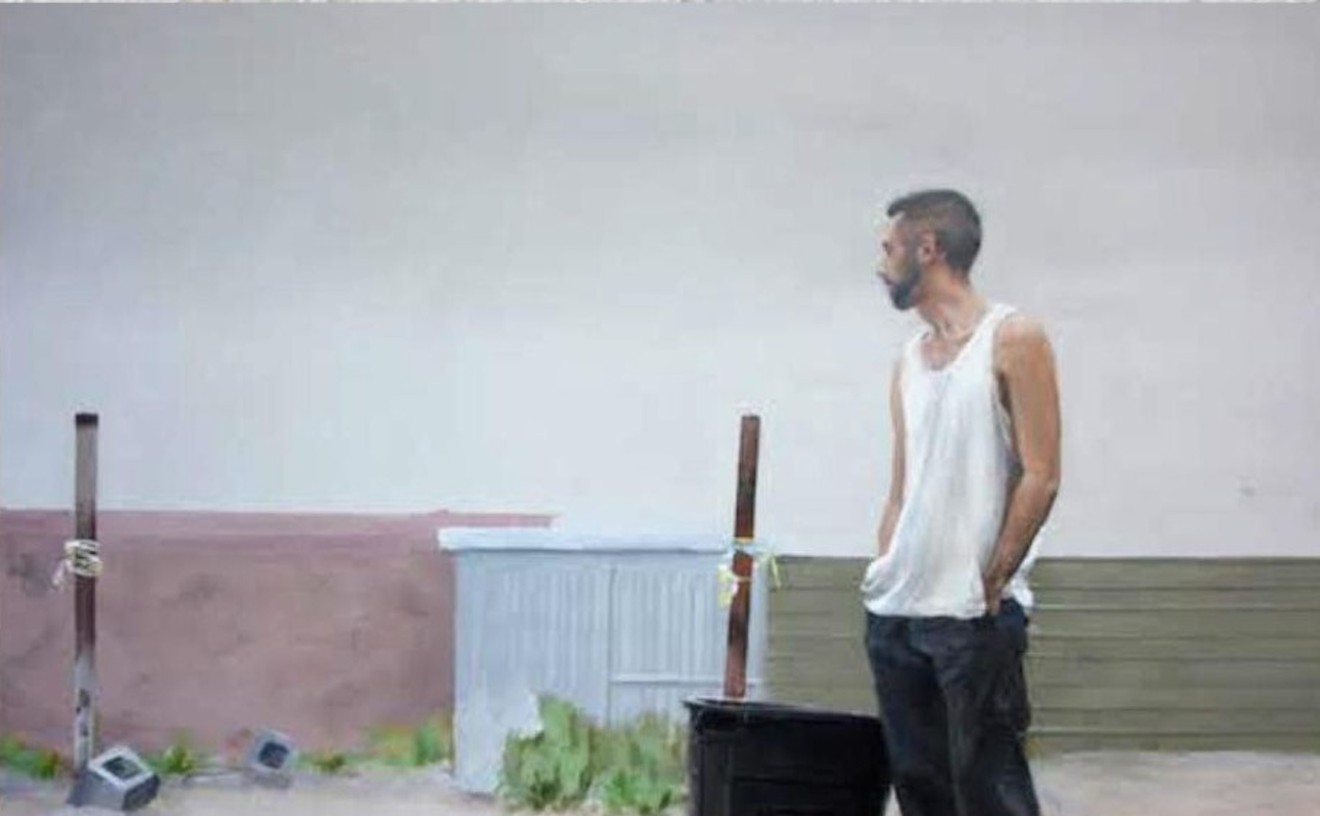Imbued with a decidedly Dantean hellishness -- but not without a certain devilish charm -- the painting, Desert Dream City #2, is one of several of the same bent now appearing in "Paintings by Annabel Livermore" at Cline Fine Art in Scottsdale. This is a pretty heady output for an elderly West Texas artist who has been described as a retired, gray-haired, glove-wearing librarian from the upper mid-West. Miss Livermore (she prefers to be addressed as such) is said to be a reclusive artist living and working with El Paso sculptor and spokesman James Magee, though she's never been seen or interviewed in person (extant interviews have been accomplished by fax).
Despite the baroque machinations Magee has engaged in for years about Annabel, it's a poorly kept secret that James Magee is Annabel Livermore. Simply put, Magee and Livermore are two very distinct personalities producing two diametrically opposite bodies of artwork, who just happen to inhabit the same body. And I've been told by Magee, who is Livermore's personal picture framer and always refers to the hermetic artist in the third person, that Miss Livermore would scoff at the very idea of multiple personalities (even though she happens to be a figment of the artist's febrile imagination). To date, Magee's ruse has been so effective that several of Livermore's collectors still do not know the artist's real identity.
Whoever Livermore may be, Swiss psychoanalytic theorist Carl G. Jung would have a veritable field day with her apocalyptic vision -- not to mention the artist herself. A student of Sigmund Freud, Jung gave to the world of psychology the archetypal concept of the anima (Latin for "soul" or "spirit"), which is the female aspect present in the collective unconscious of all males and its flipside in all females, the animus. Livermore's cataclysmic subject matter would not be foreign terrain for this master mental cartographer, since Jung was himself the victim of mind-bending visions and disturbing dreams, like the one in which a monster flood swallowed most of Europe, drowning thousands, after which the waters turned to blood. Nor would Jung be baffled by the likelihood that Livermore is essentially the physical embodiment of McGee's thinly veiled anima, his alter ego manifested in post-menopausal, grandmotherly female form.
As fascinating as the subject of Livermore's real identity is, her art, which has appeared in major museum exhibitions around the country, is much more so. Even former librarian Laura Bush, while First Lady of Texas, expressed her admiration for Miss Livermore's landscapes of Big Bend, Texas, at a 1998 exhibition she attended in Corpus Christi (demonstrating irrefutably that the First Lady has considerably better taste in art than she does in men). But Mrs. Bush might be shocked to find out that Miss Livermore paints more than just luminous Van Goghesque exterior landscapes of thick, luscious oil impasto, inspired by remote, sun baked crags of southwest Texas and New Mexico. This allegedly refined lady artist also creates gritty interior landscapes of grimy hustler bars and transvestite hangouts in Juarez, the Mexican border town across from El Paso -- most probably the wellsprings from which she drew the foreground figures in Desert Dream City #2.
In Desert Dream City #5, eerie sand dunes (or perhaps it's a golden tsunami) roll through the canvas, one of which is scarred with a deep opening from which a woman in a polka-dotted sundress helps a tiny man up a ladder. In the distance, city buildings twist against the horizon. To the left, a dark silhouette of a woman carrying a towering multi-colored cane leads a child over the undulating hills; to the right, a drippy chair teeters magically on one leg. The focal point of the painting is a rather Byzantine Madonna and child, though this Madonna is devoid of her usual benign countenance, this one's face a study in concern.
Female solicitude set against catastrophe repeats as a theme in There's a Boy in the Corn Field, which, according to James Magee, was originally inspired by Miss Livermore's visit to the chili fields around Hatch, New Mexico. However, those chili fields have been transmuted into cornfields that melt into an ocean horizon dotted with flaming military ships. And instead of crop circles or corn fungus, this cornfield is sprouting an erupting volcano, as well as a small chapel and tractor in flames. The only things not on fire in this image are a boy on a bike blithely looking back at a serene grandmotherly figure. Magee says Miss Livermore thinks looks like Nellie McCarty, heiress to the Tampax fortune. What it all means is beyond me, but it's the very ambiguity and labyrinthine quality of these images that make them so intriguing.
While many of Annabel Livermore's phantasmic paintings speak of apocalypse and revelation, they also herald escape and redemption. Unfortunately, several of Miss Livermore's delicate floral watercolors, thrown heedlessly into the middle of this show without regard to their utter lack of relevance to the rest of the exhibition's work, lose their luster when set cheek to jowl with her beefy oil paintings. This is even more nonsensical when one discovers that two large, gothically framed landscape paintings from Miss Livermore's highly acclaimed Big Bend Series, I - XVIII -- infinitely more logical companions to the other oils on display -- are languishing in the gallery's back storage area. Maybe I'm crazy, but disaster and daffodils, at least in this show, just don't mix.










